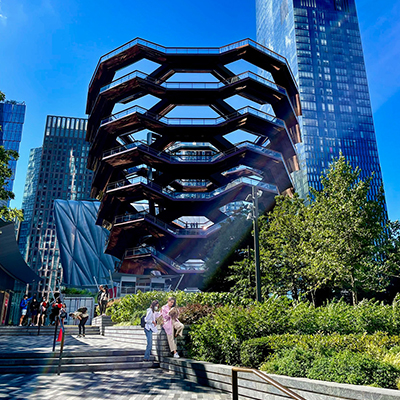Irrigating the Largest Private Real Estate Development in U.S. History: Hudson Yards
Hudson Yards — the largest private real estate development in U.S. history — includes several acres of public space, thousands of plants, and 300 mature trees, right in the heart of Manhattan. When irrigation experts Northern Designs were hired to consult on irrigation, they knew they had their work cut out for them. “Our main focus was the establishment of the trees installed in structural soil,” said Mike Astram, president of Northern Designs.

“We get proper soil moisture readings. These sensors measure evapotranspiration in real-time. Based on that, we get good indicators of how and when to schedule irrigation.”
— Mike Astram, President, Northern Designs
Additionally, the site was built over a train yard, which meant intense heat regularly emitted from the train’s infrastructure. If the soil got too warm, it would cause major problems for the landscape. The project needed an irrigation solution that would monitor soil temperatures in addition to promoting healthy plant and tree growth, in order to protect the landscape asset value.
Irrigation fit for a complex New York City landscape
Northern Designs chose to implement Baseline’s soil moisture sensors, which measure the soil volumetric moisture content while also reporting soil temperatures. The team set up the entire site to run on drip irrigation, and Baseline sensors helped them accurately pinpoint the degree to which plants and trees were established.
“We installed a separate controller just to monitor temperatures across the site,” Astram said. They ran a glycol chilling system to prevent the soil from heating up and causing problems with the trees.
Hudson Yards is a LEED project, and was the first-ever project in Manhattan to be designated LEED-Gold Neighborhood Development. The project received this certification in part because of their green infrastructure, which relies on harvested water and subsurface drip irrigation. Nearly 10 million gallons of stormwater are collected annually from building roofs and public plazas, then filtered and incorporated into the irrigation system to conserve potable water and reduce stress on New York City’s sewers.
Another complexity that added to the challenge of planning and maintaining the site’s irrigation were the aeration tubes used to give the tree roots air to grow. Northern Designs used Baseline sensors to measure soil moisture in the root zone of each plant. The team strategically installed 24 moisture sensors around the site to monitor each landscape hydrozone. “We get proper soil moisture readings,” Astram said. “These sensors measure evapotranspiration in real-time. Based on that, we get good indicators of how and when to schedule irrigation.”
An impressive feat of coordination for optimized water
The project was complex and required coordination between many trades: electrical, plumbing, lighting, and water, just to name a few.
“You can plan designs based on original projections, starting with water sources, and then working your way out from there. But things don’t always go according to plan,” Astram said. While the site was still under construction, rainwater harvesting systems weren’t available. The team used temporary city water and temporary supply lines during construction.
“One part of the site could not even be started, and you have another part of the project where trees are installed and establishment is starting,” Astram said. The team used Baseline moisture sensors to catch irregularities within the complicated irrigation environment.
“Eventually, as the system slowly got installed, we worked back to the main location to tie everything into rainwater harvesting, find a permanent location for the controller, and build up the system based on its original design intent,” Astram said.
Hudson Yards has an expansive plant palette and different plant types means different watering requirements. When you also add various phases of construction and surrounding buildings into the mix, it makes for one complex irrigation project.
“We also had to tie in the surrounding buildings to the irrigation system,” Astram said. “We had to consider who might have access to irrigation controllers and consider microclimates like sunlight, wind, and temperature factors. Sometimes you’re just taking your best guess.”
Despite the many challenging factors they had to manage, the Northern Designs team pulled it off — establishing a thriving, LEED certified site at Hudson Yards.
Highlights
- An established tree population with optimized irrigation for all plants
- Two-wire technology that provides real-time data
- Sensors’ ability to collect data 24/7 on irrigation and precipitation impact

